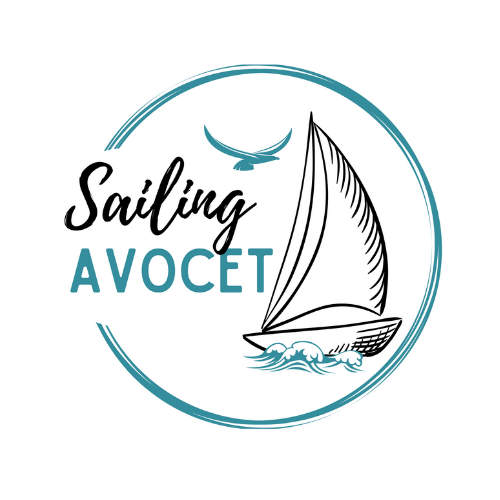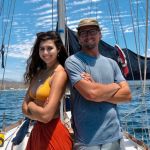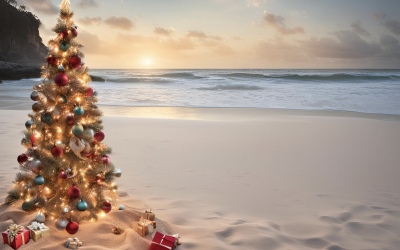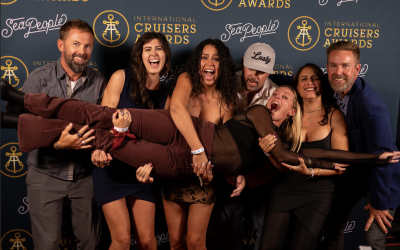“It’s time,” Chris said, his voice heavy with emotion. We embraced, both drenched in sweat, and pulled away with tears in our eyes. “We can never sell this boat,” I whispered, glancing around at Avocet’s now-empty spice rack and fruitless basket. Our collection of mugs peaked through the shelf behind our sparkling clean stove. “I know” he said before kissing my forehead, and the wall next to him before heading outside to start the engine.
After four days of cleaning, packing, and decommissioning Avocet, she was ready for her summer stay in Guaymas. Moving into an Airbnb nearby made the transition easier, giving us a place to rest and cool off after long, hot days of work. Not only did we have a comfortable bed, clean bathroom, and kitchen to return to at night after a long day of boat work, but we could relax under the AC which was becoming a necessity as the daytime highs began to rise. That morning, we walked from the Airbnb to the boat, crossing off the final tasks before heading to the hauling way.
Up We Go
As Avocet was lifted by the travel lift, I felt a mix of comfort and unease. Being onboard while she was hoisted into the air was unsettling, especially as she swayed gently. But as I looked over the starboard side, I saw the travel lift’s Perkins engine – so similar to Avocet’s, but much bigger – and felt an odd comfort in the similarity. The yard’s skilled crew handled her perfectly, securing her in place with sturdy hull stands and chalks. There we finished our decommission checklist and had the opportunity to meet the yard owner, Gabriel, who was very kind and welcoming.
Here is our decommissioning process in checklist form if you find it helpful. We will have a full article to elaborate on these points coming out soon:
 Step 1: Research Your Storage Yard
Step 1: Research Your Storage Yard
– [ ] Assess typical weather patterns for your storage location.
– [ ] Choose a secured dry storage facility with good fencing, security, and reputation.
– [ ] Verify the type of ground boats are stored on (preferably cement).
– [ ] Place metal or plywood plates under each leg of the boat’s stand for stability.
– [ ] Ensure there are 6-8 stands placed strategically along the hull.
– [ ] Secure a written agreement with the boatyard detailing rates and services.
– [ ] Confirm the yard will not move your vessel without permission.
– [ ] Check the surrounding area for available resources for DIY work.
– [ ] Consider pest prevention for wasps, ants, spiders, and cockroaches.
Step 2: Exterior Prep
– [ ] Wash down the boat thoroughly while still in the water.
– [ ] Remove, wash, flake, and store sails in sail bags in the V-berth.
– [ ] Remove lines from the mast and replace with labeled messenger lines.
– [ ] Wash sheets and lines, soak in a water, dish soap, and vinegar solution.
– [ ] Remove the windex and anemometer from the mast.
– [ ] Wrap masthead light and plastic components aloft with tin foil.
– [ ] Remove and store canvas panels from the dodger below deck.
– [ ] Cover plastic components with tin foil or custom covers.
– [ ] Drape the boat in a breathable sun cover.
– [ ] Disconnect lithium battery bank at 75% SOC.
– [ ] Service and drain outboard fluids; store outboard inside the boat.
– [ ] Stow hard dinghy upside down on deck or follow manufacturer’s storage recommendations.
– [ ] Ensure covers are in place for deck, binnacle, hatch, and any electronic components.
Step 3: Interior Prep
– [ ] Perform a deep clean from V-berth to aft.
– [ ] Place shallow pans with bleach on the cabin sole to prevent mildew.
– [ ] Do laundry and store towels, sheets, and clothes in vacuum-sealed bags with dryer sheets.
– [ ] Cover portlights with tin foil for UV protection and privacy.
– [ ] Inspect and secure all portlight seals and fittings.
– [ ] Dog down all portlights securely.
– [ ] Change engine oil, flush with fresh water, and loosen/remove rubber components.
– [ ] Pickle the watermaker for the season.
– [ ] Clean and treat electrical connections.
– [ ] Insert mesh material in dorade holes to prevent pest entry.
– [ ] Remove all perishable food items from the galley and pantry.
– [ ] Double-bag any remaining staples and add a paper towel sprayed with eucalyptus oil.
– [ ] Place roach bait in storage areas.
Step 4: The Long Farewell
– [ ] Get to know your boatyard neighbors.
– [ ] Join local Facebook groups, newsletters, or WhatsApp groups for your yard.
– [ ] Arrange for periodic checks on your boat.
– [ ] Do a final walk-around and take a celebratory photo before leaving.
Adios, Avocet
 Two days later, we found ourselves buttoning up the boat one final time, capturing one last photo together before we left. As we exited the boatyard gate, I turned back to see our beautiful girl, her bow pointed toward the sea, waiting patiently for our return in January. Leaving our first home behind is always hard, and I doubt it will ever get easier. There’s no bond quite like the one between a sailor and their boat, especially when you’ve touched every inch, inside and out, like we have with Avocet. We are bonded—she is as much a part of us as we are of her. Though our cruising adventures were paused for the summer, we had one last adventure in Mexico: leaving. It turned out to be much harder than we anticipated.
Two days later, we found ourselves buttoning up the boat one final time, capturing one last photo together before we left. As we exited the boatyard gate, I turned back to see our beautiful girl, her bow pointed toward the sea, waiting patiently for our return in January. Leaving our first home behind is always hard, and I doubt it will ever get easier. There’s no bond quite like the one between a sailor and their boat, especially when you’ve touched every inch, inside and out, like we have with Avocet. We are bonded—she is as much a part of us as we are of her. Though our cruising adventures were paused for the summer, we had one last adventure in Mexico: leaving. It turned out to be much harder than we anticipated.
“I’m going to hand you over to the cops now” I said to Max and Karen through my phone. The police officer took my phone and chatted with our friends while we all stood on the side of the highway staring at the accident in front of us. I never would have guessed our final memory of our 2024 cruising season would involve being escorted to the airport by the police, but sometimes that’s just how it goes. Let me explain:
When we initially planned to fly out of Hermosillo from Guaymas, we had arranged for a private car. However, after chatting with our friends from SV Sitka, we decided to save a few extra bucks and take a gamble with an Uber—in retrospect, that was a very, very bad idea. We should have stuck to our original plan. ANYWAYS, an Uber driver did pick us up from our Airbnb at 6:00 a.m. to drive us the two hours to the Hermosillo airport. Everything was going smoothly until we were just 20 minutes from the airport and got severely rear-ended. Fortunately, we were all okay, none of our stuff was damaged, and Cleo the cat was completely unfazed. 
So there we were, stranded on the side of the highway in Mexico with no way to get to the airport and our friends in La Cruz helping to translate the situation. Finally after a bit of back and forth, the police offered to take us. That was the first (and hopefully last) time we ever rode in the back of a Mexican polícia truck. Jokes aside, they were incredibly kind and dropped us off right at the airport gate, wishing us well on our journey.
The Final Push
“Gordita bonita,” the bag check attendant cooed at Cleo as she popped out of her carrier. It was our first time flying with Cleo, and while we were extremely nervous, we were confident our travel cat would be just fine—once we actually got her on the plane, that is. Our journey to the airport had already been eventful, but getting Cleo on board was another challenge entirely.
Even though Cleo is a registered ESA and we had properly booked her ticket for the flight, the attendants seemed baffled that she wasn’t a canine. They spent 30 minutes conversing back and forth, trying to figure out what to do, before hesitantly offering us the option of paying $150 to have her in the cabin with us. Without hesitation, we handed over the money—there was no way I was sending our kitty into the depths of the plane with the rest of the luggage.
Once on board, Cleo stayed in her carrier under the seat and seemed unfazed by the entire experience. From takeoff to touchdown, she remained curled up in a perfect ball, completely at ease. Chris and I, however, couldn’t take our eyes off her, constantly checking to make sure she was breathing okay, wasn’t dehydrated, and giving her lots of pets to remind her we were right there… even though she probably wished we weren’t. I couldn’t help but wonder if this is what it feels like to travel with a baby for the first time.
One layover and another flight later, we finally arrived in Fresno, California, where Mama Neely was waiting to pick us up and take us home to Runaground Ranch. After such a long day of travel, it felt good to be back, but the feeling of relaxation never reached us. Instead, we hit the ground running with projects, work, and other sailing-related shenanigans… but I’ll save those details for the next post.
Thank you all for an amazing cruising season! It is wild to think we started in Peñasco with Peter, and now he is in French Polynesia. We also love to reflect on all of the good people we met, and think fondly of the time spent in La Cruz as well as our big inland trip with Max and Karen. Time flies when you are having fun!
Cheers,
Marissa












0 Comments